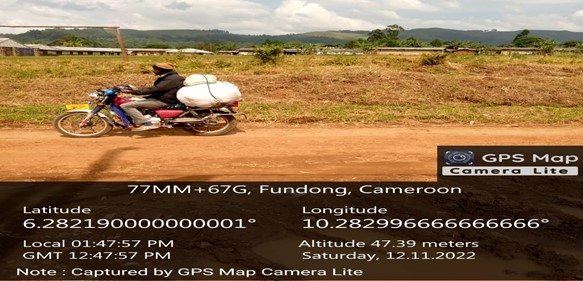Sign up for our newsletter, to get updates regarding the Call for Paper, Papers & Research.
Challenges of Small-Scale Agriculture: Evidence from Depressed Communities in Fundong Sub-Division Northwest Region, Cameroon.
- Nyamka Milton Kibebsii
- Chiatoh Fabian Ntangti
- Mary Juliet Bime Egwu
- 1303-1323
- Jan 11, 2024
- Agriculture
Challenges of Small-Scale Agriculture: Evidence from Depressed Communities in Fundong Sub-Division Northwest Region, Cameroon.
Nyamka Milton Kibebsii*1, Chiatoh Fabian Ntangti2, Mary Juliet Bime Egwu1
1Department of Agribusiness Technology, College of Technology, the University of Bamenda
2Department of Agronomy, Catholic University of Cameroon, (CATUC) Bamenda
*Corresponding Author
DOI: https://dx.doi.org/10.47772/IJRISS.2023.7012099
Received: 03 December 2023; Accepted: 12 December 2023; Published: 10 January 2024
ABSTRACT
Small-scale agriculture has become the backbone of most developing countries in the world especially Cameroon in general and Fundong Sub-Division in particular. Following the economic crisis of the early 1990s that hit Cameroon economy, there has been a steady increase in the rate of unemployment, which has paved the way for agriculture to be the leading economic activity. This investigated the challenges faced by small-scale farmers in Fundong Sub-division. The data used in this study were obtained from the survey questionnaire and interview administered on the sample of 104 households. Using cluster-sampling approach, proximity villages were grouped into four clusters villages and Purposive sampling was then used to select households to participate in the study. Descriptive statistics were used to analyse the challenges of small-scale farmers. Results obtained revealed that low agricultural production was as a results of these challenges (Poor farm to market roads, Limited access to modern farming tools, Insecurity at the suburbs, Lack of improved and resistant seed varieties etc) faced by these small scale farmers. Based on the finding this study recommends that the government should subsidize the agricultural sector and addressed the issue of farm to market road.
Keywords: Small-scale Agriculture, Challenges, Descriptive Statistics,
INTRODUCTION
Small-scale agriculture is the backbone of the economy of most developing countries in the world. It plays a vital role in promoting economic development and improve the livelihood of farmers. It is an important element of rural development and it considered as one of the major components of national economy. Small-scale agriculture have been defined differently and varies from country to country. According to (HIPE 2013, IFAD 2013), small-scale agriculture refers to those farms of less than 2.0 hectares. Small-scale agriculture production describes a farming method using very little land and often using very little to no expensive technologies. Small-scale farming is closely tied with more sustainable agricultural methods including organic, biodynamic and permacultural farms. According to the USDA, a small-scale farm produces between 1000$-250000$ each year in agricultural products.
In Cameroon, agriculture remains the backbone of its economy employing up to 70% of its workforce, and contribute about 42% of its gross domestic product (GDP) and 30% of its export revenue (World Bank 2012). The agricultural sector in Cameroon is amongst the main occupations for over 70% of citizens and contributes enormously to the country’s economy. The lack of access to adequate amount of safe and nutritious food is a public health concern worldwide and Cameroon in particular. Due to its agro-ecological diversity, Cameroon has great potentials for agricultural production to contribute towards its over 23 million people and beyond, thus contributing towards feeding the world’s 9 billion people. In Cameroon, the agricultural sector and related food processing activities account for about 50% of export earnings, contribute about 30% to the GDP and employ about 70% of the population. Agriculture is the main employment sector for the poor, employing 76.3% of the extreme and 60.7% of the moderate poor (Castañeda, et al 2016). Most of this group tend to be subsistence or semi-subsistence oriented and face significant barriers to entering higher value agricultural activities.
Cameroon’s agricultural population consists mainly of small farmers and their family members, who make up about 70% of the agricultural population. Given increasing population and settlement numbers, the use of ecologically unsustainable agricultural inputs and widespread changes in agricultural and forestry land use, trends in food production appear uncertain or rather stagnant, according to a study that predicted/expected that necessary agricultural production corresponds often the actual production. Epule et al. (2012) argued that there were 20 years between 1975 and 2005 when actual grain production in Cameroon remained below the predicted/expected level of required grain production. Epule et al.(2012) verified the vulnerability of experiencing food shortages along gender and poverty lines. Many past studies argued that, as in most sub-Saharan African countries, Cameroon is currently experiencing declines or stagnation in food production at the national scale. Agricultural adaptation requires a consideration of both human and physiographic challenges that are responsible in specific contexts. Yengoh et al. (2011) verified the role of land management practices and the socio-cultural properties of small-scale farmers in establishing differences in crop yields. Access to food is a basic human need; however, according to McMichael, many poor people lack physical and economic access to sufficient safe and nutritious food. (2009). This state of food security is caused by many factors such as job losses, low levels of education and employment, lack of access to land, single parenthood, unstable income levels and poverty of household heads. All these factors lead to a state of poverty, the main consequence of which is inadequate access to food (FAO, 2008).
Fundong sub-division is a village in Boyo Division, North West Region of Cameroon. It is found between latitude 6◦4’ and 6◦20 north and between longitude 10◦11 and 10◦30’ East. The main driven economic activity in Fundong is small-scale agriculture and other small businesses that sustain the lives of the population. Peasant farmers who use poor farming techniques like the slash and burn method and shifting cultivation mostly carry out small-scale agriculture production in Fundong. Smallholder farmers in Fundong carry out both cash /food crop production. Some of these cash/foods that sustain small scale farmers’ livelihood in the area include: coffee, kolanuts, plantains, bananas, coopeas, irish, beans, cocoayams/colocacia, garden eggs, vegetables, sugar cane, sweet potatoes and sweet potatoes. Small-scale farmers in Fundong equally carry of the production of tree fruits such as mangoes, pears, guavas, plum and pawpaw to sustain their livelihood. Fundong sub-Division in the North West Region of Cameroon is not an exceptional case of small-scale agriculture. Majority of farmers still carry out subsistence agriculture with poor farming techniques such as slash and burn, shifting cultivation. These are commonly practiced in small farm sizes of about 6 hectares of land. Small-scale agriculture is the main activity of this rural area. It is being carried out in many forms such as subsistence agriculture, cattle rearing and opening of small poultry farms for the rearing of table birds. These helps to improve and enhance the livelihood of the peasant farmers in this area.
Small-scale agriculture is a widespread activity in Fundong Sub-Division for socio-economic sustenance employing the majority of the population that depend on it for survival and livelihood. It is an economic activity in Fundong involving the cultivation of both food and cash crops. The agriculture provides food crops to sustain the food needs of most families while a number of families engage in cash crop cultivation, which generates income for other needs.
The ownership and distribution of farmland in Fundong is largely in the hands of few individuals. It is widely observed that family heads, quarter heads and chiefs decide who to give land to and the sizes. This partially explains why Small-scale agriculture is commonly practice as most farmers have small farms scattered all over the farming area. Farm plots of varying size appear to be scattered over different locations, which could explain why it is impossible for farmers to pursue large-scale agriculture. This is probably a limiting factor of Farmers to rely only on small-scale agriculture.
Small-scale farmers in Fundong Sub-Division have observed low agricultural output. Some farmlands in Fundong have been over cultivated due to limited land or probably as a result of an increase in population. Urban growth associated with horizontal expansion of urban areas has contributed to reduce farmlands in Fundong sub-division, as there is a continuous increase in population. Settlement is increasingly taking over some of the farmland while the rise in population is increasing the mouths that need to be fed but on comparatively fixed and to an extend reducing pieces of farmland. Around these growing urban areas, farming activities are being diversified while other economic activities take away potential farmers from farming activities. Many small-scale Farmers can only afford few plots of land on which the rely on for farming. These farmlands end up being cultivated all year round and often accompanied by poor farming methods like slash and burn which greatly reduces the productivity of farm produce in the long run hence reducing output. Farm inputs such as chemical fertilizers and insecticides, which could help farmers, improve yields is difficult to acquire by most farmers as their prices continue to increase.
The farm yields obtained from small-scale farming in the Sub-Division is hardly enough to meet up with the food needs of the population. The incomes of farmers appear to remain low as cash crop farming is gradually being abandoned for food crop farming. Most farmers are abandoning their coffee farms while other convert them to food crop farms with a general decline in cash crop production. The income they generate from small-scale agriculture is hardly enough for meaningful transformation of the farmers’ livelihood and their standard of living. Small-scale farmers have a greater contribution to food security and livelihood. It is for these arguments that this study seeks to analyze the challenges faced by small-scale farmers in Fundong Sub Division, the North West region of Cameroon. This paper is divided into five sections which are; introduction, literature review, methodology, results, and conclusions
LITERATURE REVIEW
Sadati, and Fami, (2010) enumerated problems facing smallholders farming as land fragmentation, low access to agro-chemicals, poor road infrastructure and low level of mechanization. A similar study by Mehrabanian and Pourkakhaki (2007) highlighted low knowledge about modern technologies, low literacy rate and lack of access to advanced farm technologies, outmoded methods for cultivation, and high-risk aversion as serious challenges holding back productivity of smallholders. Many researchers have discussed problems facing all types of farmers in Cameroon. However, the available studies failed to account for the magnitude of the challenges facing them with quantitative evidence as well as the sequential order of the problems; thus, among the numerous problems, which of them severely affect their livelihoods and would be interested for policy makers to address them with urgency (Naamwintome and Bagson 2013). In an attempt to fill this gap, factor analysis is used to evaluate the weight of each challenge to small-scale farmers in Cameroon and Fundong in particular.
Gneiting and Sonenshine, (2018) A living income is needed to afford decent housing, nutrition, healthcare, education and to cope with unforeseen or one-off expenses. Current agricultural prices combined with small scales of production and low productivity mean that few small-scale farmers earn a living income. Attention for living income has been driven in part by global agribusiness firms who have recognized that despite efforts to include small-scale farmers in their supply chains on fairer terms; their earnings still do not approach a living income
MATERIALS AND METHOD
Sample Size and Data
The sample size of the population of the study was drawn from 4244 households in the study area following the 2005 population and household census. The data used in this study were obtained from the survey questionnaire and interview administered on the sample of 104 households. Using cluster-sampling approach, proximity villages were grouped into four clusters villages as indicated on Table 1 and Purposive sampling was then used to selected households to participate in the study.
| N | Villages | Clusters | HH (Villages) | Total HH
cluster |
4% size | Total sample size | Eff. Resp | Total Eff. Resp | % of eff.
Resp |
| 1 | Mbengkas | Western cluster | 111 | 474 | 4 | 22 | 3 | 75 | |
| 2 | Baiso | 48 | 2 | 2 | 15 | 100 | |||
| 3 | Mbongkesu | 88 | 3 | 2 | 66.7 | ||||
| 4 | Aboh | 87 | 3 | 2 | 66.7 | ||||
| 5 | Mentang | 242 | 10 | 6 | 60 | ||||
| 6 | Abuh | Eastern cluster | 533 | 1981 | 21 | 78 | 11 | 52 | |
| 7 | Muteff | 159 | 7 | 4 | 36 | 57 | |||
| 8 | Mboh | 94 | 4 | 2 | 50 | ||||
| 9 | Aduke | 265 | 10 | 6 | 60 | ||||
| 10 | Achain | 302 | 12 | 5 | 42 | ||||
| 11 | Ajung | 233 | 10 | 4 | 40 | ||||
| 12 | Akeh | 151 | 14 | 5 | 36 | ||||
| 13 | Ilung | Northern cluster | 115 | 816 | 5 | 39 | 3 | 60 | |
| 14 | Mbissi | 242 | 10 | 6 | 28 | 60 | |||
| 15 | Meli | 52 | 2 | 2 | 100 | ||||
| 16 | Fundong-up | 132 | 5 | 3 | 60 | ||||
| 17 | Ngwainkuma | 71 | 3 | 3 | 100 | ||||
| 18 | Bolem | 153 | 6 | 4 | 66.7 | ||||
| 19 | Ngwah | 193 | 7 | 4 | 57 | ||||
| 20 | Atoini | 151 | 6 | 3 | 50 | ||||
| 21 | Mbam | Southern cluster | 271 | 976 | 10 | 38 | 5 | 50 | |
| 22 | Alim | 216 | 9 | 5 | 25 | 55.5 | |||
| 23 | Boyui | 115 | 5 | 3 | 60 | ||||
| 24 | Laikom | 159 | 6 | 4 | 66.7 | ||||
| 25 | Fujua | 212 | 8 | 6 | |||||
| TOTALS | 4247 | 4247 | 170 | 170 | 104 | 104 | 82.4 | ||
| Percentage | |||||||||
The population of the study area and effective respondents
HH: household, Eff. Resp. effective respondents.
Source: BUCREP (National census 2005) and field surveys, 2019
The reason for this rational use of households was that, it is much easier to administer questionnaires in households than individuals in streets and this will equally reduce cost and facilitate the work. To this effect, 4% of the households made up the sample population of this study that produce an in miniature cross section of the population. The reason for choosing a 4% sample size is in accordance with the postulation of Nwana (1982), which stipulates that:
- If the population of the study is in hundreds, a 40% or more sample will be used,
- If the population is in many hundreds, a 20% will do,
- If the population is in a few thousands, a 10% will do and,
- If the population is in several thousands, a 5% or fewer samples will do (Nwana, 1982, quoted by Agha-ah 2010).
Furthermore, the 4% chosen was to ease the work due to the fact that the Area has been facing socio-political crises and it was not easy to administer questionnaire to a very large population.
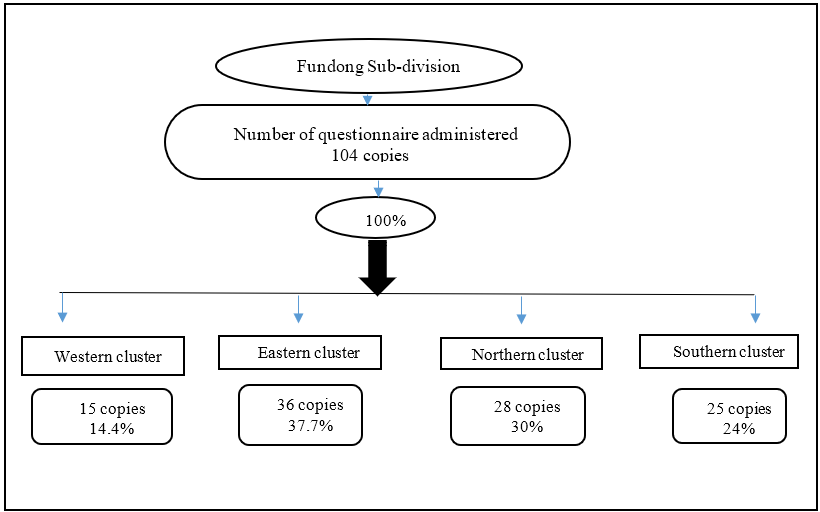
Figure 1: Spatial distribution of effective respondents in the four village clusters
Source: Drawn from table 1
Model Specification
In order to empirical achieve the objective, this study adopt the approach of the model of Mpandeli & Maponya (2014), as the argued that smallholder farming continues to play a key role in South African agriculture. However, climate variability, lack of appropriate agricultural infrastructure, shortage of farming skills, high levels of soil degradation and tough economic conditions are amongst the constraints facing small-scale agricultural productivity in South Africa. Droughts or long dry spells will worsen the situation, often resulting in complete crop failure and thereby perpetuating poverty in rural communities. The concept challenges of small scale agriculture is a multifaceted, meaning it can only be adequately measure using so many question items on the questionnaire (see table 2: indicators of Challenged).
Table 2 Indicators of Small-scale Challenges
| Item | Indicator |
| Socio-economic challenges | |
| Deteriorated infrastructure like bridges | C002_1 |
| Poor farm to market roads | C003_1 |
| Limited access to modern farming tools | C004_1 |
| Insecurity at the suburbs | C005_1 |
| Lack of improved and resistant seed varieties | C006_1 |
| Inadequate funding sources
Others (specify) |
C007_1
C008_1 |
| Environmental difficulties | |
| Dirty/polluted water | C009_1 |
| No fertile soils | C010_1 |
| Seasonal changes
Insects spoiling Crop destruction by animals Others (specify) |
C011_1
C012_1 C013_1 L014_1 L015_1 |
Source: Computed by Author (2022)
RESULTS AND DISCUSSION
The problem of Farm to market roads is a major challenge faced by farmers in Fundong. The topography off this area is made up of hills which act as a hindrance to road construction. Thus, the farms that are in the hill areas of Abuh and Ngwah are very difficult to access thereby making cultivation in such areas very difficult. Also, Drainage is another thing that cause poor far to market roads in this area. Fundong is made up of so many rivers such as Njua Ngwah, Njua effi and Njua -Meli.The existence of these rivers makes it difficult for the construct of roads to take place.
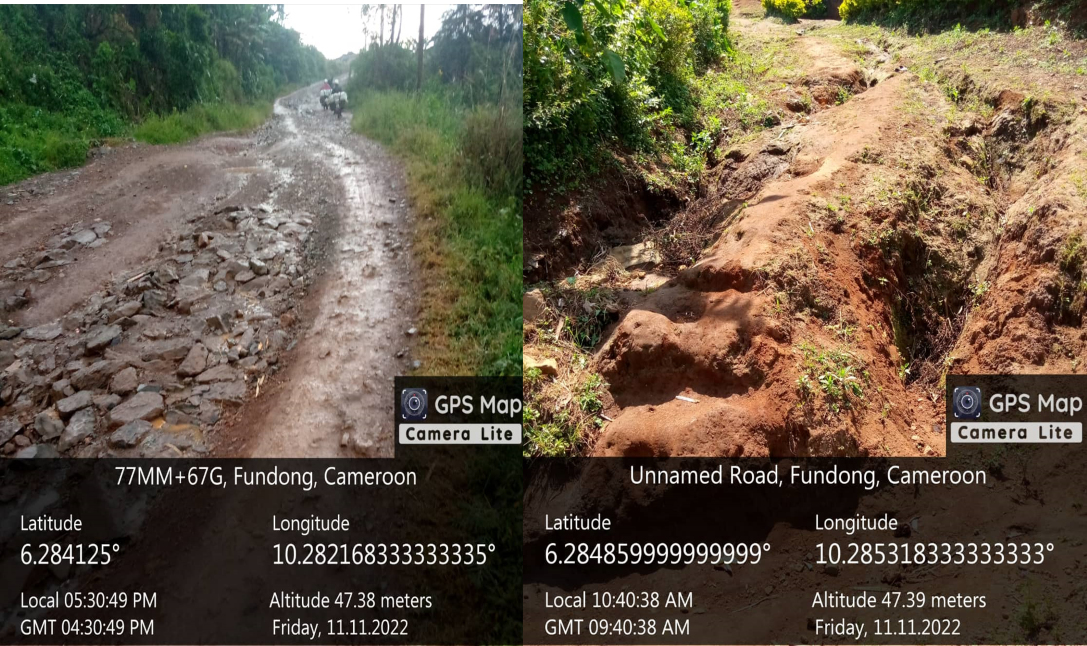
Figure 2: Poor farm to market road Source; Fieldwork, 2022
The few roads that exist in this area are seasonal road are at times the roads are very bad due to seasonal changes. For example, during the rainy season, roads are muddy and slippery thereby making movement and transportation of goods and services from one place to another very difficult. This difficulty of poor farm to market roads can be seen in figure 3 above and satistics below on table 3 below which show that about 40.4% of the targeted population agreed that the nature of farmer to markets roads in Fundong are poor. There is equally poor farm to markets roads because of lack of good bridges.
| Frequency | % | |
| Regular | 43 | 41.3 |
| Irregular | 33 | 31.7 |
| Constant | 20 | 19.2 |
| None | 8 | 7.7 |
| Total | 104 | 100.0 |
Table 3: Poor farm to market roads
Source: Fieldwork, 2022
The figure below shows the nature of roads. From the table it can be seen that 13.5% of the population indicate that the roads are excellent in nature. Following, 4.8% of the population indicates that the roads are very good, 26.9% (28) of the targeted population indicate that the roads are good in nature, 40.4% (42) of the population indicate that the roads are poor in nature whole 14.4% (15) of the population indicate that the roads are very poor in nature. The results therefore show that a majority of the population, 40.4% of the population identify that the roads are poor in nature.
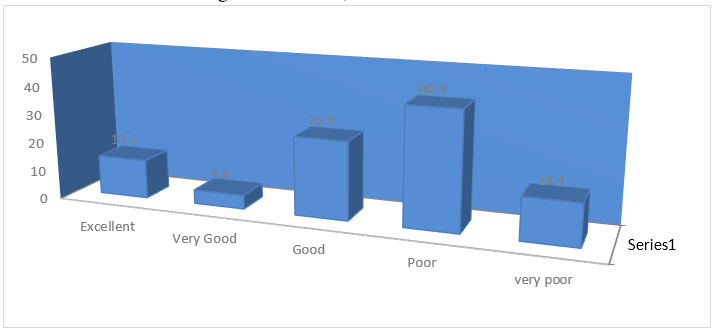
Figure 3: The nature of farm to market roads in Fundong Sub-Division
Source: Fieldwork, 2022
Furthermore, 41.3% of the targeted population identifies poor farm to market roads as a regular hindrance to farming. Following, 31.7% of the population identify it as an irregular problem, 19.2% of the population identify it as a constant problem while 7.7% of the population does not see poor farm to market roads as any hindrance to farming in Fundong sub division. From the results, it can be seen that 92.3% of the population see poor farm to market roads as a hindrance to farming. This goes to say that the farms to market roads in the sub division are not just the best, thus concluding that the farms to market roads in this area are very poor.
Road connectivity in Fundong
Road connectivity here is the density of connection of road path. Road connectivity in funding is mostly linked by foot path. Different sub-villages are connected to each other by footpath. The nature of road connectivity in this area is very poor due to some challenges such as potholes and lack of good bridge on the roads. Also, there is no maintainace on the few roads that connect different quarters. Majority of the population of about 44.2% as seen on figure indicated that road network connectivity is because of no maintenance.
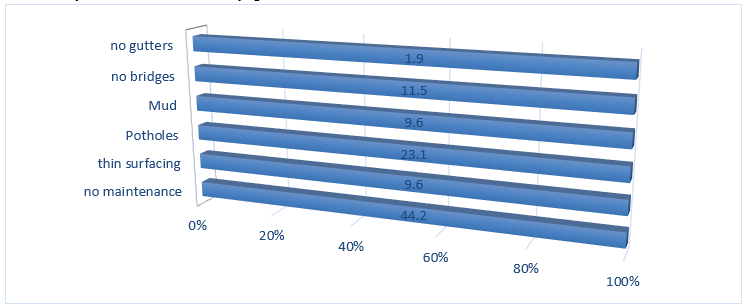
Figure 4. Road network connectivity in Fundong.
Source: Fieldwork, 2022
In relation to why the roads are either poor or very poor, the population as seen in the results indicates that no maintenance (44.2% of the population) and thin surfacing (9.6% of the population) are indicated as causes of the poor nature of roads. On the other hand, 23.1% of the population indicate potholes, 9.6% of the population indicates mud, 11.5% of the population identifies no bridges and 1.9% of the population identifies no gutters as some of the main reasons why the farm to market roads in the Fundong Sub Division are either poor or very poor. From the results, it can be concluded that several reasons account for the poor or very poor nature of roads in Fundong sub division.
Types of vehicles used by farmers for transportation.
The Farmers in Fundong Sub-Division used different means of transportation to transport their farm products. Agricultural products in Fundong is transported using mostly motor bikes.
Figure 5: A bike transporting agricultural products. Source: Fieldwork, 2022
The effects of this mode of transport on agricultural production and marketing, cultivation of large farms, making use of remote areas which are most at times very fertile. They remarked that this mode of transport will go a long way to enable farms to respond better to market signals. The results showed that farmers in this area use mostly motor bikes to transport their agricultural products as seen on figure 37 that the population of about 63.5% accepted that they transport their agricultural products using motor bikes. This is because some of their farmers are inaccessible and cars cannot go to such areas, only bikes can access such areas. Some Farmers use vehicles like Hilux.

Figure 6: Types of vehicles used by Farmers for transportation
Source: Fieldwork, 2022
The type of vehicles used as identified by the population include motor bikes ,63.5% (66) of the population and 19.2% (20) of the population indicate tricycle. Following, 1.9% (2) of the population identified the use of taxis, 3.8% of the population identified the use of hilux and 7.7% (8) of the population identifies the use of cargo trucks while 3.8% of the population identifies the use of lorries/van. From the results, it can be said that the population uses different vehicles for the transportation of farm produces from the farms to the markets. From the results, it is clear that the most used vehicle for the transportation of farm produce are motor bikes as agreed upon by 63.5% of the population.
Level of accessibility of Vehicles.
The level of accessible is a challenge to some vehicles in this area. Some areas especially the interior villages are very inaccessible. Vehicles such as taxis cannot access the most of the farmers in this area. The kind of vehicles that have easy accessibility are mostly bikes and tricycles. Some of these vehicles takes hours to access the farmers. From the results, it is clear that it takes at least some hours for one to be able to have access to a vehicle that can transport their farm produce as indicated by 40.4% of the population on table 4.
| Level of accessibility | F | % | ||||
| easy to get take hours to get take a day very hard Total |
25 | 24.0 | ||||
| 42 | 40.4 | |||||
| 10 | 9.6 | |||||
| 27 | 26.0 | |||||
| 104 | 100.0 | |||||
Table 4: Level of accessibility of the vehicles
The accessibility of the vehicles is determined by different factors as seen on the results. It shows that 24% of the population says that it is easy to access their choice vehicle for transportation, 40.4% of the population identifies that it takes hours to get a vehicle to transport their farm produce. On the other hand, 9.6% of the population indicates that it takes a longer time to be able to get a vehicle for the transportation of farm produce while 26% of the population identify that it is very hard to get a vehicle for the transportation of farm produce. From the results, it is clear that it takes at least some hours for one to be able to have access to a vehicle that can transport their farm produce as indicated by 40.4% of the population, the majority.
Information regarding the services of vehicles.
The farmers in Fundong use various means to get information regarding the vehicles that transport their farm products and the time the vehicle takes to arrive the farms. The farmers used an easy timetable like a watch timer to get the information. The major way through which these farmers get their information regarding the services of vehicles is through the sound alert system. About 38% of the population agreed that they main way the get information regarding the services of the vehicles is through the sound alert system as seen on Figure 38. The vehicles for this transportation usually arrived their destination very late. The Farmers said at times the vehicles keep them waiting for so many hours and at times, they don’t even come at all.
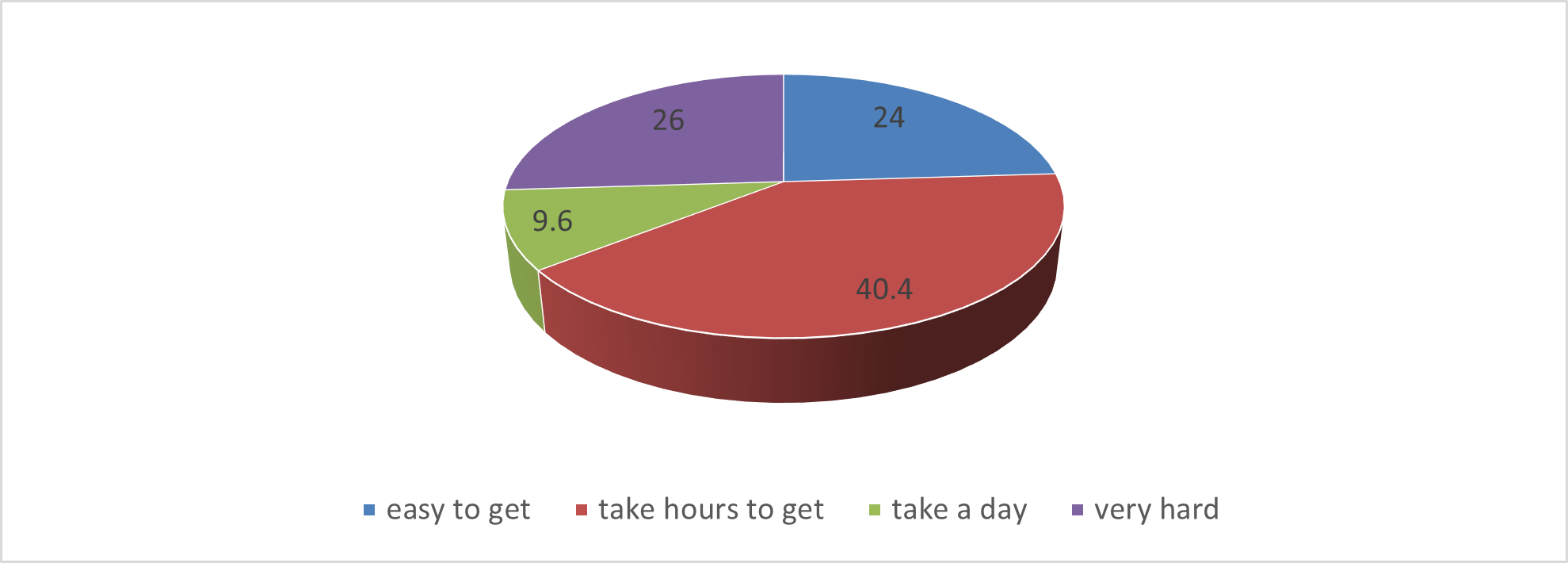
Figure 7. Information regarding the services of vehicles
Source: Fieldwork, 2022
To understand the degree of availability of information in regards to the services of vehicles, 18.3% of the population identified that there is an easy timetable that they use, 12.5% of the population identify that they have reliable news about the services of the vehicles while 28.8% of the population identify that the it is easy to get information regarding the services of vehicles in relation to the weather issues. To continue, 38.5% of the population identified that sound alert system is how they have information about the services of vehicles while 1.9% of the population indicated that they have different ways to have information regarding the availability of information regarding the service of vehicles that can transport their farm produce. From the results, it is clear that the sound alert system (38.5% of the population) is the highest means to have available information on the services of vehicles that can transport farm produce in Fundong Sub-Division.
Level of security of road transport network in Fundong.
Road transport network has been an important factor to rural development and agricultural production in particular. From the results, Road transport network security in Fundong is moderate as seen on table 19 which show that about 37.5% of the population accepted that road network security is moderate. The nature of road security here is mostly centered on physical aspect such as terrorism and theft. Some risky activities such as stealing takes place in most roads in this area. Table 24 explain the level of security of roads in Fundong
| Level of security of roads | F | % | |
| Excellent well secured Moderate Insecure very insecure Total |
22 | 21.2 | |
| 18 | 17.3 | ||
| 39 | 37.5 | ||
| 17 | 16.3 | ||
| 8 | 7.7 | ||
| 104 | 100.0 | ||
Table 5: Level of security of road transport network
Source: Fieldwork, 2022
In relation to how secured the road transport network is, it was identified that 21.2% of the population identified the road transport network to be excellent, 17.3% of the population identified the road transport network is well secured, 37.3% of the population identified that the rod transport network is moderate. On the other hand, 16.3% of the population identified that 16.3% of the population identified the road transport to be insecure while 7.7% of the population identified the road network transport to be very insecure. From the results it can be concluded that the road network in Fundong sub division is moderate as a majority of the population indicate that it is moderate.
Duration of Farmers to arrive their Destination.
The duration and the time the farmers in Fundong Sub-Division varies differently in accordance to different locations. Most high agricultural outputs in Fundong is being gotten from the suburbs where natural and good fertile soil still exist and thus this farmers trek for long distances before they arrive their destination. Some of these farms are in far into the interior villages where farmers cannot go and return the same day. Some go to such farmers using bikes and the bike can take about 4-5 hours before arriving the destination. From the results, it was accepted that most of the farmers arrived their destination late since most distance to the farms are very far. This can be best explained by figure 39, which shows that about 57.7% of the population accepted that they arrived their destinations late. Other farmers around the town arrived their destination early especially those whose farms are just around their homes.
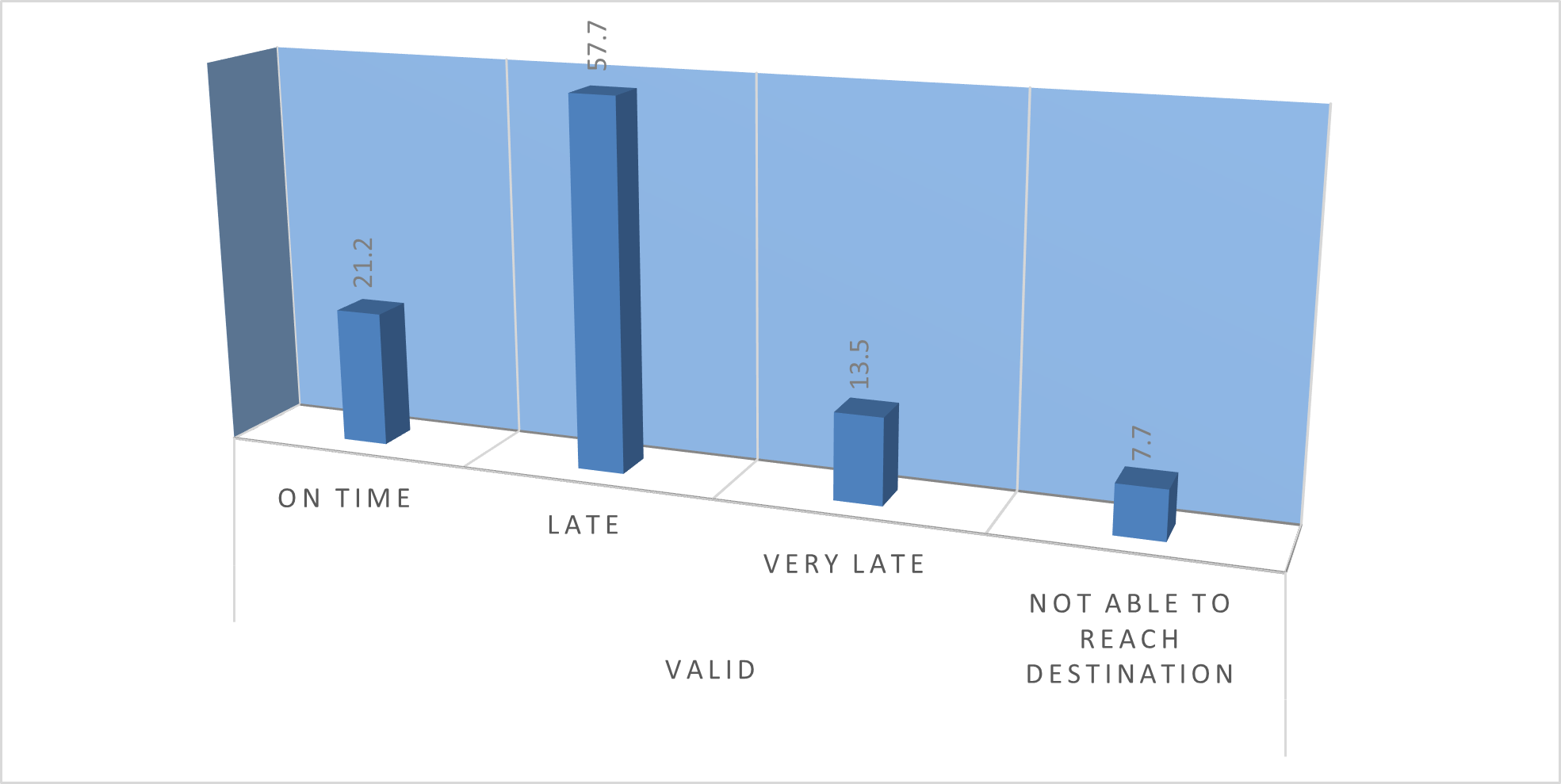
Figure 8. Duration taken by farmers to arrive their destination.
Source: Fieldwork ,2022
The results show that 21.2% of the population identify that they arrive their destination on time, 57.7% of the population identify that they arrive their destinations late, 13.5% of the population indicate that they arrive their destinations very late while 7.7% of the population identify that they reach they are not able to reach their destinations. From the results, it can be concluded that most of the farmers and farm produce reach their destinations late because of the nature of roads and type of vehicles used as indicted by a majority of 57.7% of the population.
Socio-economic challenges of small scale agriculture in Fundong
Deteriorated infrastructures such as bridges.
Deteriorated bridges are one of the challenges faced by most farmers in Fundong. Most of the roads linking many farmers in Fundong are disrupted by so many rivers, some of these rivers do not have bridges, and even the few ones that exist are deteriorated due to overuse without maintenance. This make transportation of agricultural output from such areas very difficult. The results revealed that deteriorated bridges have resulted to many accidents which have even cause the lives of some farmers in this area especially during the rainy season. During the rainy season some of the rivers overflow their banks and carryout bridges. At times it happens and cause people to drown. The findings show that about 36.7% of the population accepted that deteriorated bridges are a great hindrance to agriculture in this area as seen on figure 9.
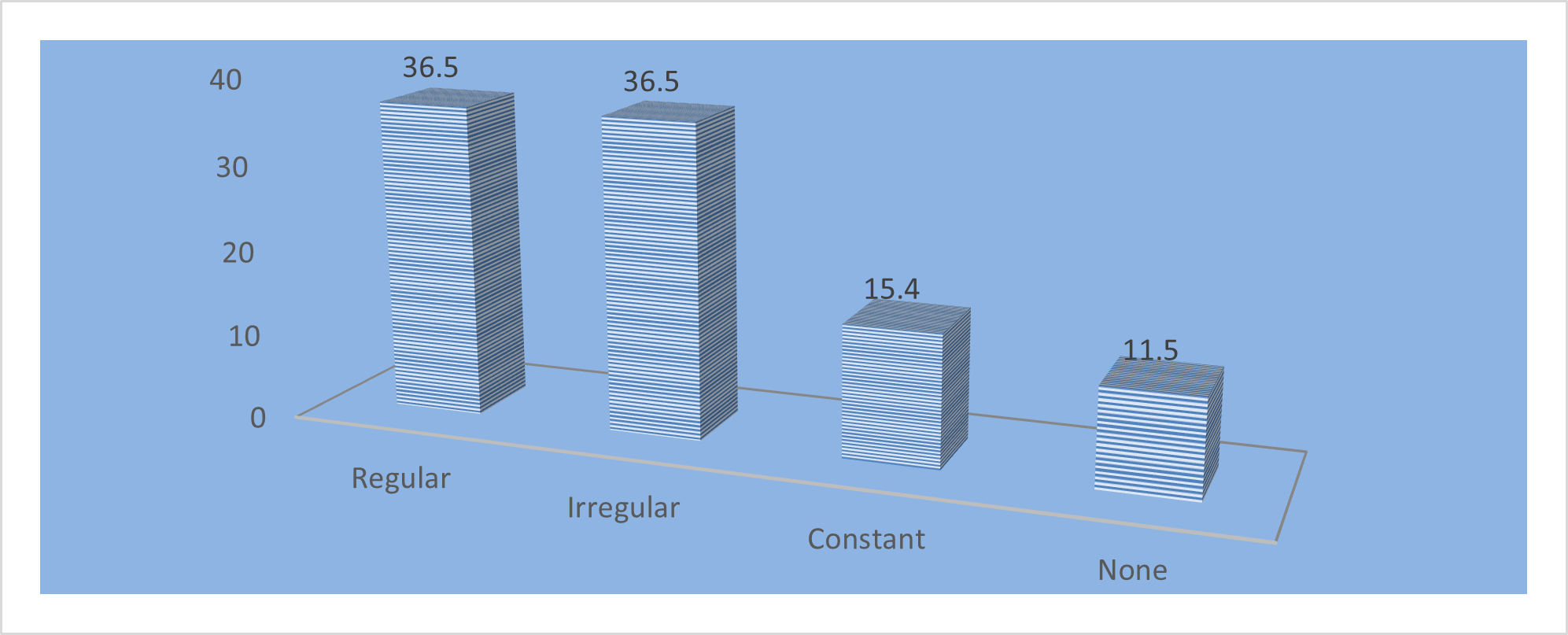
Figure 9. Deteriorated infrastructure like bridges
Source: Fieldwork, 2022
Deteriorated infrastructure like bridges is one of the challenges faced in farming. From the results, it can be seen that 36.5% (38) of the population identify deteriorated infrastructure as a hindrance to farming. 36.5% (38) of the population identify it as an irregular problem, 15.4% (16) of the population identify it as a constant problem whole 11.5 % (12) of the population does not see deteriorated bridges as a hindrance to farming. From the results, it can be concluded that 88.5% of the population identify that deteriorated infrastructure like bridges is a hindrance to farming.
Limited access to Modern farming tools
Limited access to modern farming tools is another challenge faced by farmers in Fundong. Most of the farmers in this area are local farmers who practice peasant farming in very smaller quantities and thus they do use local farming tools such as hoes cutlasses and axes. The farmers lack modern farming tools like tractors, which can enable them to cultivate large pieces of land. The farmers do not have the means to get modern farming tools because the cultivate on very small pieces of land and the output too is usually very small and can’t permit them to have much money from the sales of the product and thus it difficult for them to raise huge sums of money that can buy them modern farming tools. From the findings, 76.9% agreed that limited access to modern farming tools as seen on the figure below
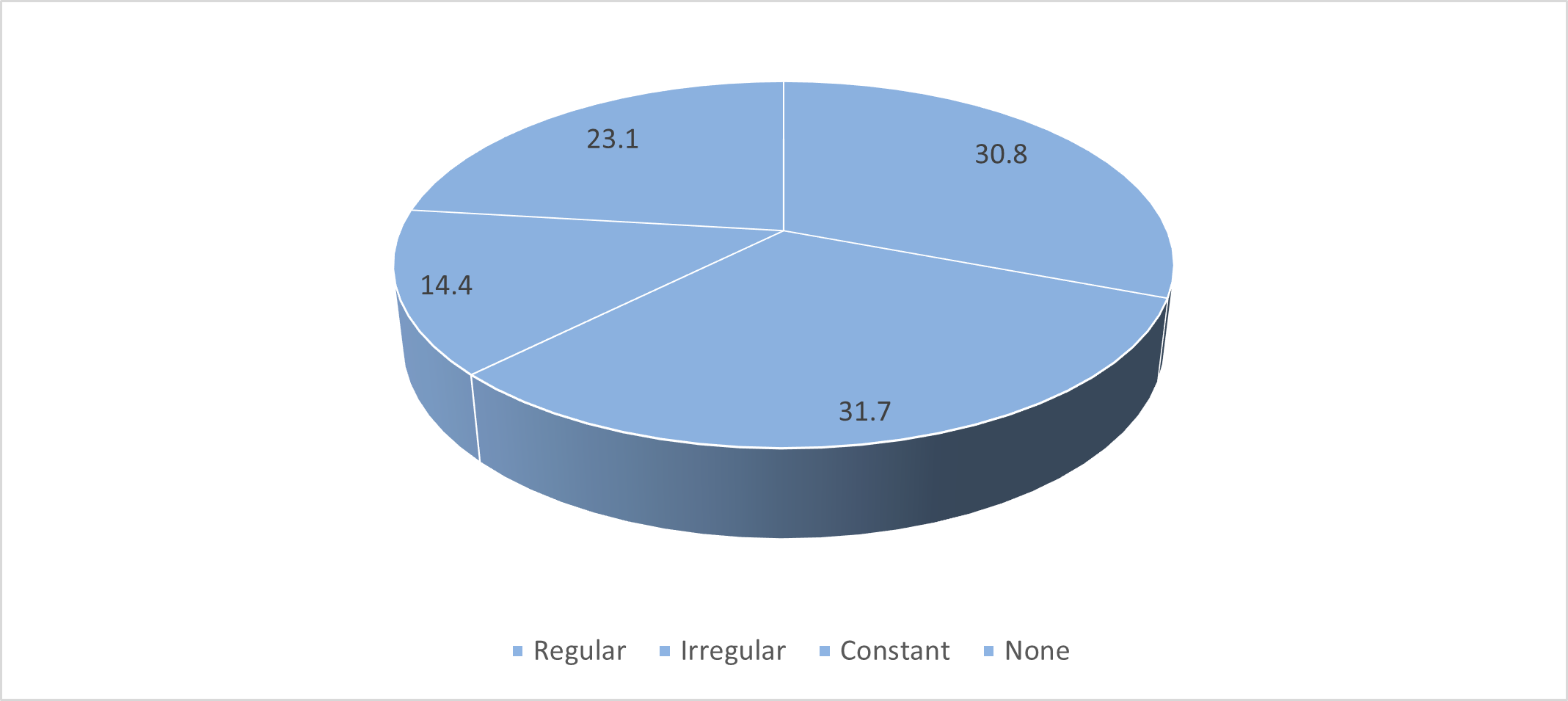
Figure 10. Limited access to modern farming tools
Source: Fieldwork, 2022
To continue, 30.8% of the population identifies limited access to modern farming tools as a regular problem to farming. Following, 31.7% of the population sees it as an irregular problem, 14.4% of the population find it as a constant problem while 23.1% of the population does not see it as a problem. The results go to say that 76.9% of the population agrees to the fact that limited access to modern farming tools hinders farming.
Insecurity at the suburbs.
Farmers in Fundong Sub-Division faces great insecurity at the suburbs. It was revealed by the results that highest yields and high agricultural output comes from the suburbs, which still have natural fertile soils. Insecurity in these suburbs is associated with this ongoing crisis. Most of these boys hide in suburbs and they act as a hindrance to most farmers because they have been attacking some farmers and even seized their farm products. This has made some farmers to abundant some of their farmers in suburbs thereby making them to suffer the effects of limited land to cultivate in. The findings show that about 38% of the population agreed to the fact that insecurity at the suburbs is a regular challenge faced by farmers as on table 6.
Table 6. Insecurity at the suburbs
| Rates of insecurity | F | % |
| Regular | 40 | 38.5 |
| Irregular | 32 | 30.8 |
| Constant | 14 | 13.5 |
| None | 18 | 17.3 |
| Total | 104 | 100.0 |
Source: Fieldwork, 2022
For insecurity at the suburbs, 38.5% of the population identified that insecurity at the suburbs as a regular challenge to farming. 30.8% of the population identified insecurity at the suburbs as an irregular problem, 13.5% of the population identified as a constant problem while 17.3% of the population did not find it as a problem. The results go to show 82.7% of the population show that insecurity at the suburbs is a challenge that hinders farming.
Lack of Improved and resistant seed varieties.
The farmers in Fundong are faced with the problem of lack of improved and resistant seeds. The farmers here are poor local farmers who are unable to afford good resistant seeds. They just struggle to select their future seeds from their previous harvest. At times some farmers do not even bother to select the bad seeds from the bad ones, they just plant like that and end of having very low yields. It just of recent that some CIGs have been helping some of the farmers to provide them with seeds. The results show that 86.5% of the population agreed that lack of improve and resistant seeds is the main cause of low agricultural output and a great hindrance to Farming in this area as seen on table 7.
Table 7: Lack of improved and resistant seed varieties
| Lack of resistant seeds. | F | % | |||
| Regular | 24 | 23.1 | |||
| Irregular | 39 | 37.5 | |||
| Constant | 27 | 26.0 | |||
| None | 14 | 13.5 | |||
| Total | 104 | 100.0 | |||
Source: Fieldwork, 2022
Another challenge, which hinders population, is lack of improved and resistant seeds. The results show that 23.1% of the population identify it as a regular problem, 37.5% of the population identify as an irregular problem, 26.0% of the population identify it as a constant problem while 13.5% of the population does not identify lack of improved resistant seeds as a hindrance to farming. The results go to say that 86.5% of the population sees that lack of improved and resistant seeds is a hindrance to farming to them.
Most of the farmers in Fundong Sub-Division are faced with the problem of inadequate funding. They lack capital to afford all their farm inputs. Little money they got from the sales of their produced is been use to afford their only their basic necessities and they don’t enough capital to invest in intensive agriculture. From the findings, ii can be concluded that inadequate funding is a general challenge faced in Farming as about 73.1% of the population accepted that inadequate funding is one of the major challenges faced by farmers in Fundong Sub-Division as seen on table 8
Table 8: Inadequate funding sources
| Rate of Inadequate funding | F | % |
| Regular | 38 | 36.5 |
| Irregular | 19 | 18.3 |
| Constant | 19 | 18.3 |
| None | 28 | 26.9 |
| Total | 104 | 100.0 |
Source: Fieldwork, 2022
Inadequate funding sources are one of the challenges in farming identified. The results show that 36.5% of the population see inadequate funding sources as a regular problem, 18.3% of the population see it as an irregular problem, 18.3% of the population see it as a constant problem while 26.9% of the population identified that inadequate funding sources does not affect farming. From the results, it can be concluded, the 73.1% of the population identified that inadequate funding sources is generally a challenged faced in farming.
Other challenges faced by farmers in Fundong include: lack of skills and effective organization, limited land and poor water management. These other challenges can be seen on Figure 11.
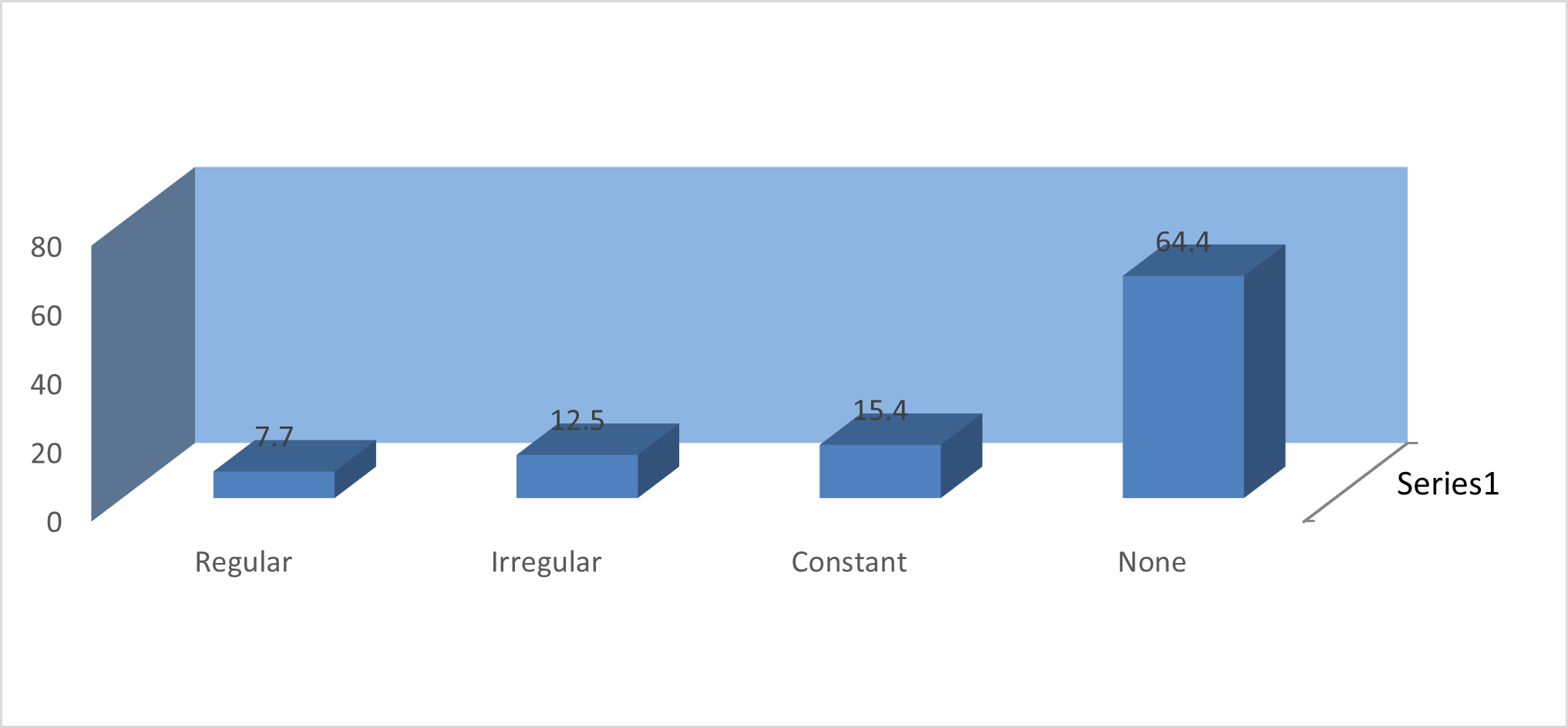
Source: Fieldwork, 2022
Other challenges identified by the population were identified to be regular by 7.7% of the population, 12.5% of the population identified them as irregular while 15.4% of the population identified them as constant problems. On the other hand, 64.4% of the population did not identify any extra challenges that might hinder farming in Fundong sub division. The other challenges identified include Environmental challenges to farming such as hills and rivers.
Water pollution is another major challenge faced by farmers and the entire population of Fundong. In other to protect crops from Bacteria and insects, the farmers in Fundong use chemicals and pesticides, when this substance seep into water bodies they became very harmful to aquatic life and human beings thereby polluting the fresh water. This issue of water pollution is very regular and common in this area as seen on table24 where the majority of the population of about 36.5% agreed that water pollution is common in Fundong.
Figure 11: A Polluted water source
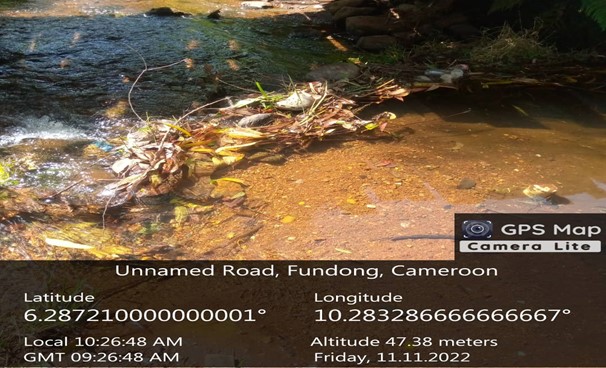
Source: Fieldwork, 2022
Water pollution in Fundong is a common and regular challenge to both the farmers and the environment. Most Farmers in Funding use chemicals to spray their farmers during cultivation and these chemicals are later emitted into water bodies thereby by polluting the water source. This water pollution is very dangerous to the environment and human health. Water pollution destroys aquatic ecosystem. Table 9 below explains this.
Table 9. Dirty/Polluted water
| Rates of Polluted water | % |
| Regular | 32.7 |
| Irregular | 36.5 |
| Constant | 9.6 |
| None | 21.2 |
| Total | 100.0 |
Source: Fieldwork, 2022
The table above shows that 32.7% of the population has a regular problem of dirty and polluted water, which hinders them from farming. Furthermore, 36.5% of the population identifies that they have an irregular problem of dirty/polluted water, which hinders them from practicing agriculture meanwhile 9.6% of the population indicated that the dirty/polluted water is a constant difficulty they face in their practice of farming. On the other hand, 21.2% of the population identify with the fact that they do not have any problem with dirty/polluted which causes them difficulties in farming. From the results, considering a cumulative percentage of 78.8%, it is clear that dirty/polluted water is one of the difficulties farmers face while carrying out their farming activities.
Environmental challenges
No fertile soils as a challenge to farming.
Another environmental difficulty that prevents farmers from farming in Funding sub division is the problem of infertile soils. The major causes of soil fertility depletion in Fundong are; inadequate use of fertilizers, complete removal of the crop residues, continues cropping systems and lack of proper cropping systems. The farmers in this area practice continuous cropping system where they cultivate like two to three times on the same piece of land thereby causing the soil to lose it fertility due to overuse. Also, Farmers in this area poorly used fertilizers, they apply excess fertilizers on the farmers thereby leading to soil infertility. The population experience regular soil infertility as seen on figure 12.
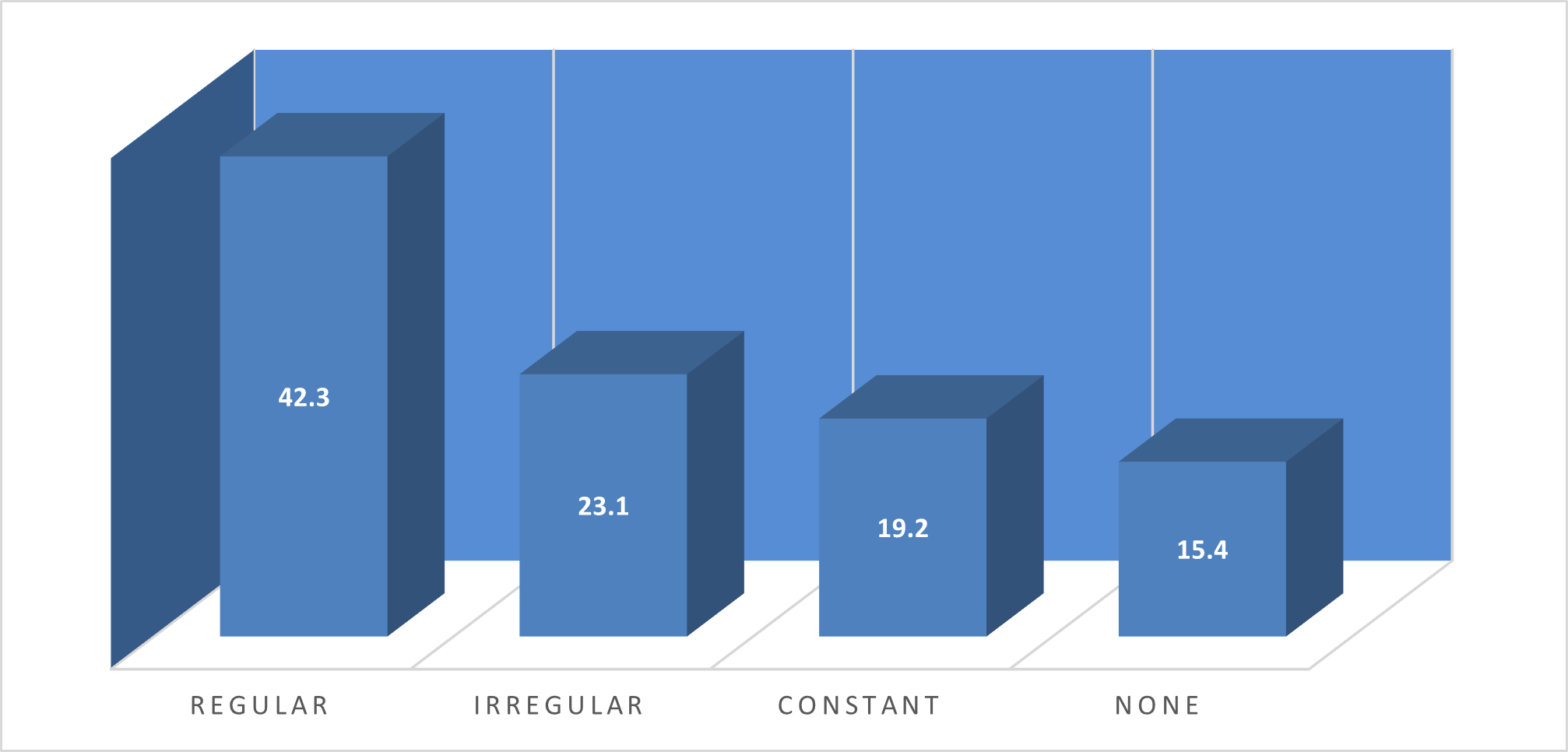
Figure 12. No fertile soils as a challenge to farming
Source: Fieldwork, 2022
From the results, it was be seen that 42.3% (44) of the population have a regular difficulty with the absence of fertile soils, which prevents them from farming. 23.1%(24) of the population show that they often have an irregular difficult in farming due to lack of fertile soils while 19.2% (20) of the population shows that they have a constant problem with the absence of fertile soils which causes them not to farm. From the results, it was be seen that infertile soils pose as an environmental difficulty, which prevents farmers from farming.
Seasonal changes.
Seasonal changes is another natural challenge faced by farmers in Fundong. Farmers in this area faces difficulties of in watering their crops during the dry season due to reduction in the volume of water from water sources. They equally experienced low outputs during the dry season as many pests and insects affects the crops during this period. Farmers in Fundong faced difficulties in transporting their farm products during the rainy season due to bad roads. During the rainy season, most of the roads in this affected by mud which makes movements very difficult. From the results 82.7% of the population agreed that seasonal changes is a major problem that affects farming in Fundong as seen on table 10.
| Rates of seasonal changes | F | % |
| Regular | 43 | 41.3 |
| Irregular | 38 | 36.5 |
| Constant | 5 | 4.8 |
| None | 18 | 17.3 |
| Total | 104 | 100.0 |
Source: Fieldwork, 2022
Furthermore, seasonal changes was identified as one of the environmental challenges to farming. From the results, it was observed that 41.3% of the population agrees that seasonal changes are a regular difficulty that prevents them from farming. 36.5% of the population agrees that seasonal changes pose an irregular environmental difficulty that prevents them from farming. Following, 4.8% of the population indicate that seasonal changes is a constant challenge which prevents them from carrying out farming while 17.3% of the population do not find any fault with seasonal changes. The results therefore show 82.7% of the population agrees to the fact that seasonal changes are a problem that affects their farming patterns.
Bushfires as a constraint to Farming.
For the past years, bush fires have been a major constraint to farmers in Fundong that prevent them from farming. Bush burning in this area is being used as farmers as a means of clearing and by grazers as a way of emerging soft grazing grass. This bush fires have more disadvantages than advantages in this area. This bush fires have devastated effects loss of lives and properties related health issues such as cancer. During Slash and burn method of cultivation in this area, the fire at times is uncontrollable and it might result to burning of people’s houses around the farm. The smoke from the burning fires equally destroy some tree fruits and other crops in the farm. The results revealed that 40.4% of the population agreed that bush fires is a major constraint to farming in Fundong as seen on table 11
Table 11: Bush fires as a constraint to farming in Fundong.
| Rates of bush fires | F | % |
| Regular | 42 | 40.4 |
| Irregular | 24 | 23.1 |
| Constant | 24 | 23.1 |
| None | 14 | 13.5 |
| Total | 104 | 100.0 |
Source: Fieldwork, 2022
Bush fires were further identified as one of the main challenges plaguing the farming sector in Fundong Sub-Division. From the results, it was seen that 40.4% of the population identifies with the fact that bush fires are a regular environmental difficulty that often hinders them from carrying out farming. On the other hand, 23.1% of the population agree that bush fires consist of an irregular environmental difficulty that prevents them from farming while 23.1% of the population identifies bush fires as a constant difficulty that prevents them from farming. A total cumulative population of 86.5% therefore agrees that bush fires hinder them from farming while 13.5% of the population remain neutral to this fact.
Hills/Stones farms as a challenge to farming.
Another challenge to farmers in Fundong is the existence of hills and stones in this area. Fundong in made up of so many hills and such places are very difficult to access. The few hills that are accessible are made up of stones which makes farming on the hills very difficult. Also, very few crop types do well on hills and thus many farmers are avoiding hill top farming in this area. From the findings, 82.7% agreed that hills/ stones are some of the environmental challenges that restrict farming in Fundong as seen on figure 13 below.
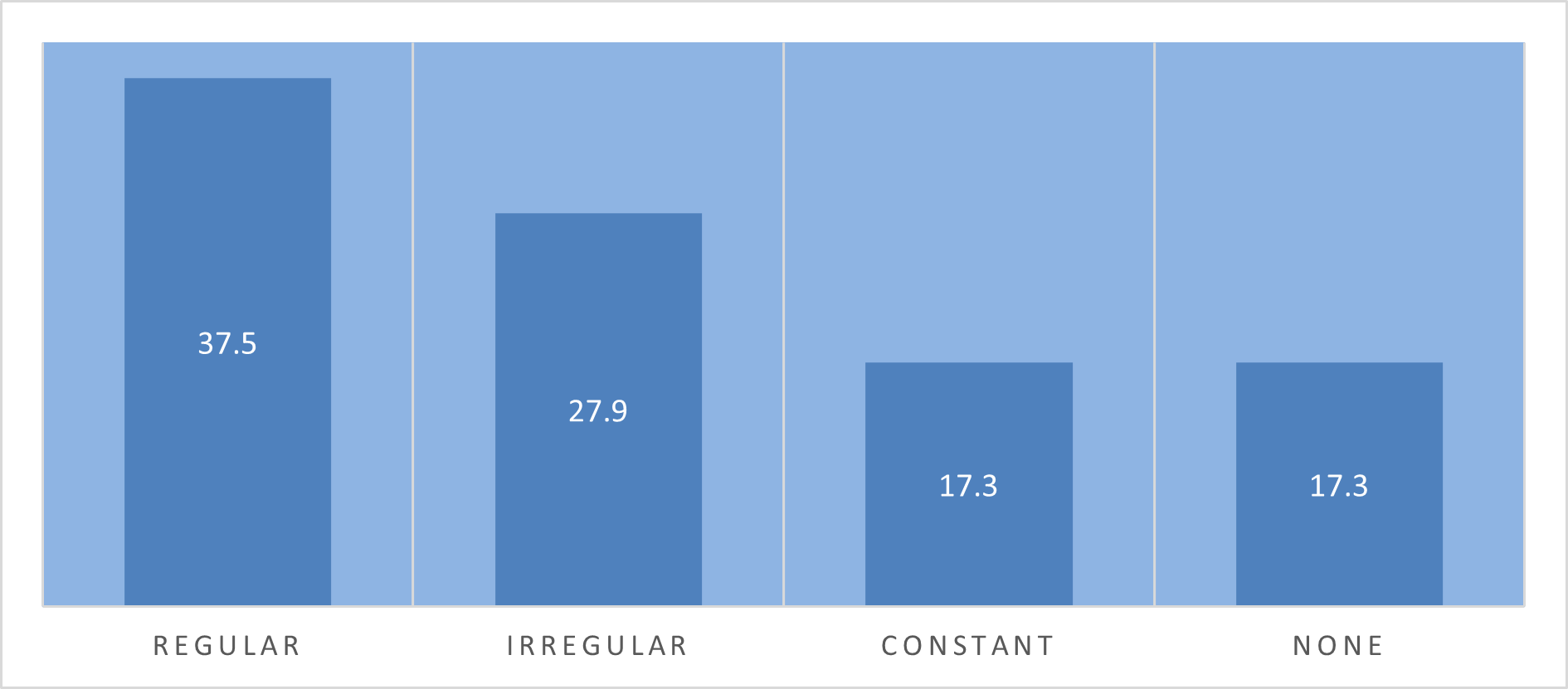
Figure 13. Hills/stones farms as a challenge to farming
Source: Fieldwork, 2022
Hills and stones in farms were identified as an environmental difficulty, which prevents farming. From the results, it was seen that 37.5% of the population identifies that hills/stones pose a regular difficulty to them when they are farming. On the other hand, 27.9% of the population identify that hills/stones pose an irregular difficulty, which sometimes prevents them from farming while 17.3% of the population identified hills/stones as a constant environmental difficulty that prevents them from farming. The results therefore show that 82.7% of the population agree that hills and stones are an environmental challenge that often prevents
them from farming while 17.3% of the population do not see hills and stones as an environmental challenge.
Insect spoiling crops is another constraint to farming in Fundong. The effect of these insects can be directly by injury to plants eating it leaves and burrowing holes on the stems of the plants. The insects equally destroy fruits by stinking them. Also, the insects equally affect crops indirectly by transmitting bacterial, viral and fungal infection to the crops. The results show that 86.5 % see insects spoiling crops as a major challenge to farming as seen on table 12.
Table 12: Insects spoiling crop
| Rates of insects | Frequency | % |
| Regular | 35 | 33.7 |
| Irregular | 31 | 29.8 |
| Constant | 24 | 23.1 |
| None | 14 | 13.5 |
| Total | 104 | 100.0 |
Source: Fieldwork, 2022
In relation to insects destroying the crops, 33.7% of the population agree that it is a regular problem that prevents them from farming while 29.8% of the population see it as an irregular problem. On the other hand, 23.1% of the population identify that insects destroying crops pose a constant problem that prevents them from farming while 13.5% of the population do not see insects destroying crops as any challenge. From the cumulative percentage of 86.5% of the population who see that, insects destroying crops are a major challenge to their farming. It can therefore be concluded that insects destroying crops pose a serious challenge to farming in Fundong Sub Division.
Crop destruction by animals is another challenge observed in Fundong Sub-Division. Many farmers in this area suffer from destruction of crops by animals. Some of the animals that destroy crops in this area include; monkeys and cows. Many farmers in this area have stopped the growing of crops some wild animals like. Some grazers during nomadism allow cattle to get into people’s farmers cause great destruction and loss to farmers in that area. The results revealed that 83.7% of the population agreed that crop destruction by animals is challenge that hinders farming in Fundong as seen on figure 14 below.
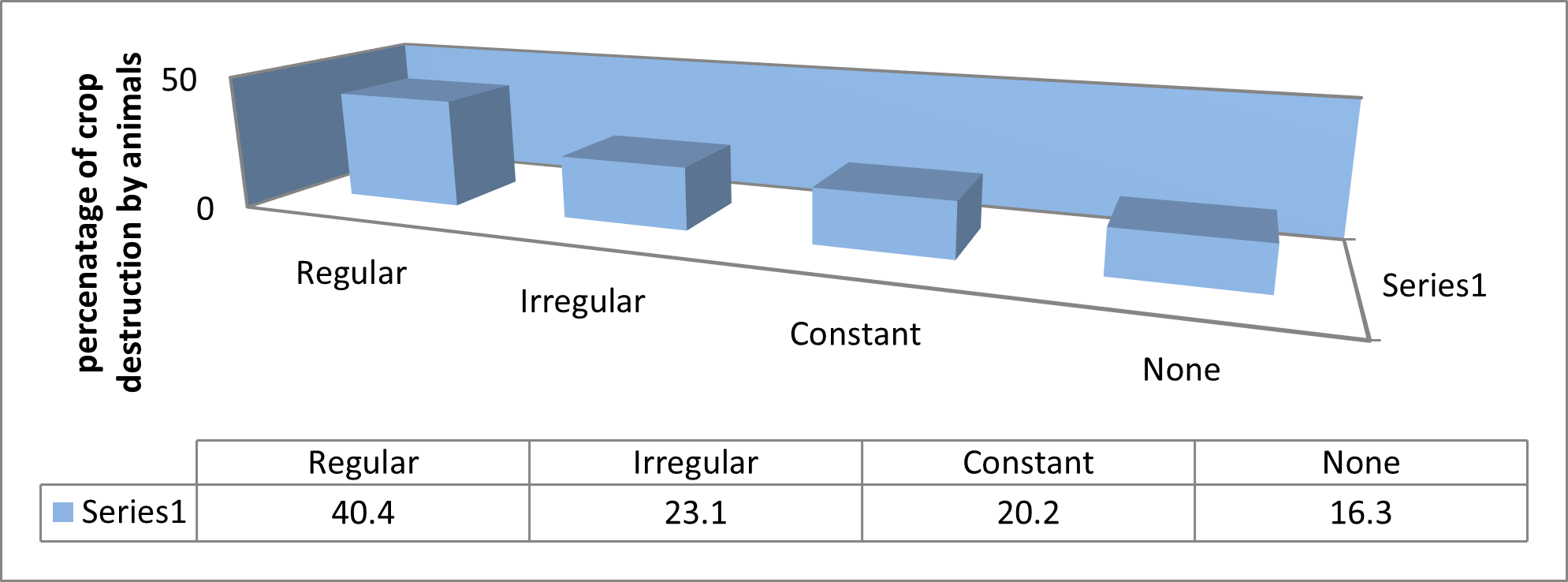
Figure 14. Crop destruction by animals
Source: Fieldwork, 2022
Crop destruction by bush animals is another environmental problem that was identified. from the results, it can be seen that 40.4% (42) of the population found it a regular problem, 23.1% (24) of the population found it an irregular problem, 20.2% of the population found it a constant problem while 16.3% ( 17) did not identify it as a challenge. The results lead to the conclusion that crop destruction by animals is a challenge that prevents farming as identified by 83.7% (21) of the population.
DISCUSSION OF RESULTS
Small-scale agricultural sector plays a key role in food and cash crop production, economic growth, poverty alleviation, job creation and rural ecosystem management in Cameroon. With regards to natural resource management and territorial development, the sector’s role is significantly conspicuous. This type of farming supports a higher percentage of the total populations through several activities including petty trading in farm products and the provisions of other related services (Hazell et al 2006; Wiggins 2009, Diao 2010). Nevertheless, in spite of these significant contributions to local food security, price fluctuation, pests and diseases infestation, low financial power, low productivity and others characterize small-scale agriculture. The sector is considered a high-risk area by the financial sector due to the unpredictable nature of their production. Entire small-scale production is rain-fed, aggravated by climate change which makes financing riskier to commercial banks and other financial institutions. Land and labor productivity of small farmers are also low due to factors such as low quality of soil nutrient, rudimentary equipment usage, poor infrastructure, lack of consistent investment by both the government and private stakeholders to the agriculture sector. The results in this study align with those put by Diao (2010) as the challenges identified in this study are quite numerous. From the results it can be seen that some of the challenges faced include deteriorated infrastructures (88.5%), poor farm to market roads (92.3%), limited access to modern farming tools (76.9%), insecurity at the suburbs (82.7%), Lack of improved seeds and resistant variety (86.5%) and inadequate funding sources (73.1%). Some environmental challenges identified include dirty/polluted water (78.8%), no fertile soils (84.6%), seasonal changes (82.7%), bush fires (86.5%), hills and stones in farms (82.7%), insects destroying crops (86.5%) and animals destroying crops (83.7%). This shows that they are actually challenges to small-scale agriculture.
According to Sadati, and Fami, (2010) enumerated problems facing smallholders farming as land fragmentation, low access to agro-chemicals, poor road infrastructure and low level of mechanization. A similar study by Mehrabanian and Pourkakhaki (2007) highlighted low knowledge about modern technologies, low literacy rate and lack of access to advanced farm technologies, outmoded methods for cultivation, and high-risk aversion as serious challenges holding back productivity of smallholders. Many researchers have discussed problems facing all types of farmers in Cameroon. The results from this study also go forth to identify some challenges that small farm holders face which align with those identified by Sadati and Fami (2010). These challenges identified are deteriorated infrastructures (88.5%), poor farm to market roads (92.3%), limited access to modern farming tools (76.9%), and insecurity at the suburbs (82.7%), Lack of improved seeds and resistant variety (86.5%) and inadequate funding sources (73.1%). Some environmental challenges identified include dirty/polluted water (78.8%), no fertile soils (84.6%), seasonal changes (82.7%), bush fires (86.5%), hills and stones in farms (82.7%), insects destroying crops (86.5%) and animals destroying crops (83.7%).
CONCLUSION
The objective of the study was to investigate the challenges of small-scale agriculture in Fundong sub-division, Cameroon using descriptive statistics. Based on the finding this study recommends that the government should subsidize the agricultural sector and addressed the issue of farm to market roads. Introduce new farming method, adequate training programs, seminars, just to mention a few to help the depressed agricultural population.
REFERENCES
- Castañeda, A., Doan, D., Newhouse, D., Nguyen, M.C., Uematsu, H. and Azevedo, J.P. 2016. Who are the poor in the developing world? Policy Research Working Paper Washington, DC: World Bank Group.
- Food and Agricultural Organization(2015a). Rural Livelihoods Monitor: Methodological Note for Household Survey Processing.
- Food and Agricultural Organization, (2011). The State of food insecurity in the World: How does international price volatility affect domestic economies and food security.
- Hazell, P. (2011). Five big questions about five hundred million small farms, Rome: International Fund for Agricultural Development. Available at: http://193.194.138.127/events/agriculture/doc/papers/hazell.
- Sadati, S.A., Shabanali-Fami, H., Kalantari, K., Mohamadi, Y., and Asakere, A. 2010. Investigating effective factors on attitude of paddy growers towards organic farming: a case study in Babol County, Journal of Applied Sciences, Engineering and Technology 3(4):362–367.
- Yengoh, G.T. Determinants of yield differences in small scale food crop farming systems in Cameroon. Agric. Food Security. 2012Vol.1 No.19pp.(1 December 2012)ref.59


